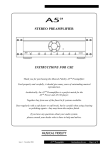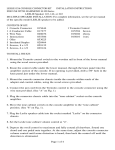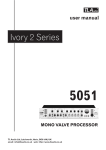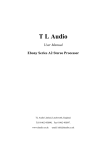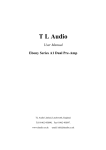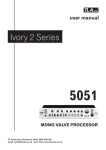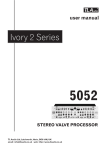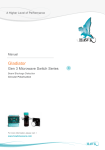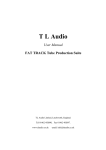Download A3 - TL Audio
Transcript
T L Audio User Manual Ebony Series A3 Mono Processor TL Audio Limited, Letchworth, England. Tel 01462 492090, Fax 01462 492097. www.tlaudio.co.uk email: [email protected] CONTENTS INTRODUCTION ......................................................................................................................................... 3 WHY CLASS-A?............................................................................................................................................ 4 WHY TUBES?................................................................................................................................................ 4 WHY BALANCED I/O?.................................................................................................................................. 5 BLOCK DIAGRAM...................................................................................................................................... 6 PRECAUTIONS ............................................................................................................................................ 7 INSTALLATION........................................................................................................................................... 8 AC Mains Supply. .................................................................................................................................... 8 Mic Input.................................................................................................................................................. 8 Line Input. ................................................................................................................................................ 9 Instrument Inputs..................................................................................................................................... 9 Insertion Point. ........................................................................................................................................ 9 Output..................................................................................................................................................... 10 Ventilation.............................................................................................................................................. 10 OPERATION ............................................................................................................................................... 11 Input Stage. ............................................................................................................................................ 11 Microphone Input. ................................................................................................................................. 11 Line Input. .............................................................................................................................................. 11 Instrument Input. ................................................................................................................................... 11 30dB Pad................................................................................................................................................ 12 90Hz Filter............................................................................................................................................. 12 Phantom Power. .................................................................................................................................... 12 Tube Stage Drive and Peak LEDs........................................................................................................ 12 WHAT IS COMPRESSION? ........................................................................................................................... 12 Overview of Compressor Operation. ................................................................................................... 13 Threshold. .............................................................................................................................................. 13 Attack and Release. ............................................................................................................................... 14 Gain Make Up. ...................................................................................................................................... 15 Compressor On...................................................................................................................................... 15 Equalisation. .......................................................................................................................................... 15 LF Band.................................................................................................................................................. 16 Mid Band................................................................................................................................................ 16 HF Band................................................................................................................................................. 16 EQ On..................................................................................................................................................... 16 EQ Pre.................................................................................................................................................... 16 Output Gain. .......................................................................................................................................... 16 Digital Output........................................................................................................................................ 17 Output Peak LED. ................................................................................................................................. 17 GETTING STARTED ................................................................................................................................ 18 CONNECTIONS. ........................................................................................................................................... 18 IN USE ......................................................................................................................................................... 19 SPECIFICATION ....................................................................................................................................... 21 Mic Input:............................................................................................................................................... 21 Line Input:.............................................................................................................................................. 21 Instrument Input: ................................................................................................................................... 21 High Pass Filter: ................................................................................................................................... 21 Insertion Point:...................................................................................................................................... 22 Output: ................................................................................................................................................... 22 Tube Stage: ............................................................................................................................................ 22 Compressor: .......................................................................................................................................... 22 Equaliser:............................................................................................................................................... 22 1 Metering:................................................................................................................................................ 23 Power Requirements: ............................................................................................................................ 23 Dimensions: ........................................................................................................................................... 23 SERVICE ...................................................................................................................................................... 24 2 INTRODUCTION The TL Audio Ebony Series of audio processors are a sleek looking range of discrete Class A processors designed to heighten your audio experience; they use signal paths constructed from discrete transistor “Class A” circuits, with switchable variable drive tube stages, putting you in control of how ‘creamy’ or how ‘cool’ your unit sounds. These techniques provide very high quality, uncoloured audio, with the option to add valve warmth at the touch of a button. Hand assembled in England to the highest standards, the Ebony uses stylish, quality chrome knobs together with a high gloss black finish to make the exterior look just as smooth as the circuits sound. The Ebony Series have all the features you come to expect with TL Audio, including balanced I/O, multi input options, analogue VU metering and intuitive, precise controls. All units are also compatible with the TL Audio DO-2 digital SPDIF interface for easy digital connectivity with high quality conversion. A combination of supreme quality, unrivalled sound and stylish aesthetics - this range offers superior analogue processing to accompany a digital world. The Ebony Series A3 Processor is a single channel unit, accepting mic, line and instrument inputs. Processing includes gain and phase control, compression and equalisation. A tube stage may be switched into the signal path, with variable drive control. The block diagram of the processor is shown in fig.1. A discrete Class A electronically balanced mic input amplifier is used, delivering superior audio performance with very low noise, low distortion and wide bandwidth. The mic input is suitable for low impedance (150-600 ohm) microphones, with a gain control range of +16 to +60dB. Front panel switches provide 48V phantom power, and 30dB pad for high output mic applications. The front panel mounted jack socket is suitable for a variety of sources, including electric guitar, acoustic pickup and keyboard. The instrument input has high/low switching, and a dedicated valve input stage. Phase reverse and high pass filter switches are provided; affecting whichever of the mic, line and instrument inputs are selected. The tube stage has a variable drive control, with the signal level indicated by the variable intensity “Drive” LED and “Peak” LED. Use of this feature typically introduces 1% to 10% harmonic distortion, predominately second harmonic, without changing the output level from the unit. The tube stage can be selected or bypassed as required. The Compressor has continuously variable threshold, ratio and gain make-up, and switched settings for hard or soft knee and fast or slow attack and release times. 3 The Equaliser has 3 bands. The HF and LF controls are shelving whilst the mid control is a swept, peaking filter. Comprehensive switching (via relays) allows the A3 to be configured with the equaliser pre or post the compressor, or with the equaliser in the sidechain, for deessing or frequency variable compressor effects. A VU meter is provided, which can be selected to either input or output signals. It may also be selected to display the compressor Gain Reduction. In this mode the meter normally indicates 0dB, falling back as the signal is compressed. The amount of compression may be read directly from the dB scale. The meter is also provided with a “+10dB” switch, which keeps the reading on the scale when driving a high level out (to a DAW, for example). In the +10 mode, 0VU is calibrated as +14dBu out. Why Class-A? Class A circuits are designed with a constant current flowing through all of the transistors, which is sufficient to drive the peak output required from each block of the circuit. This ensures that every transistor is kept at its optimum operating point, minimising non-linearities due to changes in current and internal thermal effects, and eliminating the objectionable “cross-over” distortion typical of class AB circuits. Due to the higher steady state (or “quiescent”) currents used, the power dissipation of class A circuits is substantially higher than can in general be handled by integrated circuits. It is also possible to design discrete transistor circuits to operate at higher voltage rails than are available for audio integrated circuits, adding the benefit of greater headroom and improved dynamic range. For these reasons, there are no integrated circuits in the audio paths of the Ebony Series. The outstanding audio quality is reflected in the technical specification of the units, with particularly low noise and distortion, and wide frequency response. Why Tubes? Valves - or “Tubes” - have long been associated with excellent audio quality, recognised as adding “warmth” or “depth” to a signal. Driving the valves harder results in an increasing level of mainly second harmonic distortion, which is responsible for the characteristic overdriven valve sound. The Ebony Series feature variable drive valve circuits, which may be switched into the audio paths, or bypassed completely. The valve drive control varies the signal level through the valve stage, without affecting the overall gain from input to output. It is therefore possible to vary to the degree of harmonics added by the valve, from subtle 4 warming to crunchy overdrive, with a single control. The signal level through the valve is displayed by the variable intensity “Drive” LED and the “Peak” LED. Where instrument inputs are present on the Ebony models, dedicated valve input stages are used. Switchable to high or low sensititivity (and impedance), these input stages represent the ultimate quality for the first stage of instrument amplification. Why Balanced I/O? Balanced I/O (Inputs and Outputs) are always preferable to unbalanced connection in an audio system. A balanced signal consists of signal phase and non-phase connections, which form a differential pair, independent of the ground (or earth) connection. Noise, particularly mains hum and high frequency interference can often be present in unbalanced systems due to small differences in ground potential or circulating ground currents (“loops”) between units, where the signal phase (only) is taken as an absolute value with respect to ground. A correctly designed balanced interface should have both phase and non-phase signals of equal magnitude (and source impedance), but should allow either of the phase and non-phase signals to be connected to an arbitrary electrical point (e.g. ground) without changing the differential level. Therefore, if, for instance, the non-phase signal is shorted to ground by an unbalanced input on a piece of equipment, then the phase signal should double in magnitude to compensate. Such an arrangement is referred to as “floating” or “ground-free”. Balanced signals require 3 pin connectors, such as XLR’s or TRS jack plugs, carrying the phase and non-phase signals, plus a screening ground connection. Naturally, the Ebony Series features balanced, ground-free signals for all line inputs and outputs, as well as insertion points where present. The range is also compatible with unbalanced equipment, as described above. Please read this manual fully before installing or operating the Processor. 5 BLOCK DIAGRAM 6 PRECAUTIONS The T L Audio Ebony Series units require very little installation, but like all electrical equipment, care must be taken to ensure reliable, safe operation. The following points should always be observed: - All mains wiring should be installed and checked by a qualified electrician, - Ensure the mains operating voltage stated on the rear panel is correct before connecting to the mains supply, - Never operate the unit with any cover removed, - Do not expose to rain or moisture, as this may present an electric shock hazard, - Replace the fuse with the correct type and rating only. Warning: This equipment must be earthed. 7 INSTALLATION AC Mains Supply. The unit is fitted with an internationally approved 3-pin IEC connector. A mating socket with power cord and mains plug is supplied. All mains wiring should be performed by a qualified electrician with all power switched off, and the earth connection must be used. Please note that when using this unit with alternate supply voltages (in foreign countries, for example) the internal wiring of the unit may be set for 115V (accepting voltages in the range 110V to 120V, 60Hz AC) or to 230V (for voltages in the range 220V to 240V, 50Hz AC). If the wiring needs to be changed, the unit must be taken to an approved service centre. Alternate supply voltages may also require a different power cable or mains plug. If in doubt, consult local electrical regulations. Warning: attempted operation on the wrong voltage setting, or with an incorrect fuse, will invalidate the warranty. Audio Inputs. Mic Input. There is a female, 3-pin XLR connector, for connection to a microphone. The microphone will normally be balanced, but unbalanced connections may also be made as follows: Balanced inputs: - Pin 1 = Ground (screen). - Pin 2 = Signal Phase (“+” or “hot”). - Pin 3 = Signal Non-Phase (“-” or “cold”). Unbalanced inputs: - Pin 1 = Ground (screen) - Pin 2 = Signal Phase (“+” or “hot”). - Pin 3 = Signal Ground 8 Line Input. A second 3-pin XLR connector is provided for connection to a line level source. The signal may be balanced or unbalanced, and connections may also be made as follows: Balanced inputs: - Pin 1 = Ground (screen). - Pin 2 = Signal Phase (“+” or “hot”). - Pin 3 = Signal Non-Phase (“-” or “cold”). Unbalanced inputs: - Pin 1 = Ground (screen) - Pin 2 = Signal Phase (“+” or “hot”). - Pin 3 = Signal Ground. When using unbalanced mic or line signals, the signal ground may be obtained by linking pins 1 and 3 in the mating XLR connector. Do not leave pin 3 open circuit, as this may result in a loss of level and/or increased noise. Good quality screened cable should be used, particularly for microphone or low level sources, to prevent hum or noise pickup. Instrument Inputs. A 2 pin (mono) jack plug is required, which should be wired as follows: - Tip = Signal Phase (“+” or “hot”). - Screen = Ground. Insertion Point. The insertion point is balanced, with separate TRS jacks for send and return. 3 pin TRS jack plugs should be used, wired as follows: - Tip = - Ring = Signal Phase (“+” or “hot”). Signal Non-Phase (“-” or “cold”). 9 - Screen = Ground. Unbalanced equipment may be interfaced with the processor insertion point, by wiring the plugs with ring and screen connected together. The insertion point is “half normalled”, i.e. a plug inserted into the Send socket will provide an additional signal output, without breaking the signal flow within the processor. When a plug is inserted into the Return socket, however, the internal signal is interrupted and replaced with the insertion return signal. Output. The output is via balanced, 3 pin male XLR connector. The mating connector should be wired as follows: - Pin 1 = Ground (screen), - Pin 2 = Signal Phase (“+” or “hot”), - Pin 3 = Signal Non-Phase (“-” or “cold”). If an unbalanced output is required, pins 1 and 3 should both be connected to ground. Ventilation. The unit generates a moderate amount of heat internally, which should be allowed to dissipate by convection through the grills in the sides and front panel, which must not be obstructed. Do not locate the unit where it will be subject to external heating, for example, in the hot air flow from a power amplifier or on a radiator, or in direct sunlight. The unit may be free standing, or mounted in a standard 19” rack. 10 OPERATION Input Stage. The input gain control sets the level of the mic, line and instrument signals into the Ebony A3. The 2-position button above the input gain and ‘Tube Warmth’ knob selects the signal source. Input choices are ‘Mic’ (for dynamic or most ribbon microphones and condenser microphones that require phantom power), ‘Line’ and ‘Instrument’. For condenser microphones, you should also press the 48V button to activate phantom power. The Instrument input allows high impedance instruments such as guitars or a bass etc to connect directly into the Ebony A3 and eliminates the need for a DI (Direct Injection) Box. For even better performance you also have a button at the input stage to enable you to switch between high and low impedance instrument inputs. Increasing the input gain control setting will also have a pronounced effect on the amount of compression, as the threshold will remain constant as the input level increases. If the input gain is adjusted the threshold can be readjusted accordingly to maintain a similar amount of compression. Microphone Input. When using the Ebony A3 with a microphone source, care should be taken not to apply too much gain at the input. Start with the input gain control set to minimum, and the output master at the mid-point (12 o’clock position). The input gain can then be gradually increased until the VU meter registers about 0VU on normal signal level, when set to read ‘IN’. The master output level should then be adjusted to produce the required output. CAUTION: Never switch phantom power on or off, or plug/unplug a microphone with phantom power applied unless the output level controls turned down. Failure to do so may result in a thump in your monitor loudspeakers or PA system. Line Input. A line level signal should already be at about the correct operating level, but monitoring the level on the output meter, with the compressor bypassed and the output gain at 0dB, could check this. The input gain should be adjusted until the meter reads about 0VU at normal audio level, when set to read ‘IN’. Instrument Input. The front panel instrument input socket is suitable for low level sources such as hi impedance microphones, pick ups or passive guitars, and higher level sources such as active guitars and keyboards, as it is switchable to high or low sensitivity. 11 30dB Pad. Occasionally – when using sensitive condenser microphones – the source signal may be too loud for the input preamp. In this situation, to avoid any overloading or distortion of the mic preamp stage, the 30dB pad can be used to reduce the input gain to a more manageable level. The 30dB pad only applies to the microphone input. 90Hz Filter. The high pass filter switch restricts the low frequency response of the preamp, to effectively remove rumble of LF noise from the signal. The filter can be useful in restricting ‘popping’ on vocals or even low frequencies caused by contact with microphone stands or microphone cables. Popping is an undesirable thump that is caused by close-miking certain spoken or sung letters, namely “P” or “B”. These particular letters cause a sudden expulsion of air that can result in an audible thump. As this thump has a lot of low frequency content the high pass filter can help to reduce the problem, as can using a pop filter (a device usually made out of nylon material similar to stockings) suspended in front of the microphone. The 90Hz filter is active on the mic, line and instrument inputs. Phantom Power. +48V phantom power is available at the mic socket, selected by a front switch. Phantom power should only be used in conjunction with suitable microphones. CAUTION: Operation of the phantom power switch, or plugging a microphone in or out with phantom power applied, may cause a click or thump in your loudspeakers. To prevent this happening, ensure that the system gain is set to minimum (e.g. on your mixing console fader or power amplifier), before operating the switch or plugging in a microphone. Tube Stage Drive and Peak LEDs. These LEDs indicate the drive level to the tube, or valve, stage. The Drive LED is a variable intensity indicator, starting to glow when the tube harmonic distortion is around 1%, and being fully illuminated at approximately 5% harmonic distortion. The distortion is predominately second harmonic, unless very high drive levels are used, in which case the tube is eventually pushed into harsher saturation, indicated by the tube Peak LED. What is Compression? Compression is an essential but often misunderstood process in modern recording. Put simply, compression reduces the difference between the loudest and the quietest levels 12 of an audio signal. This is known as reducing the “dynamic range” of that signal and is a powerful tool for an engineer helping to avoid overloading, distortion problems as well as raising the level of the quieter parts of the audio signal. Before the introduction of compressors the only way this could be achieved was by “gain riding”, whereby an engineer would control the fader manually in order to try and anticipate very large levels (which might distort the signal) or very low levels (which may get lost in noise). The introduction of compression devices meant that this process could be controlled automatically, allowing the engineer to get on with more productive jobs! Many instruments and voices have a very wide dynamic range that need to be controlled. A singer, for instance, may be singing quietly one moment and very loudly the next, and unless compression is applied the vocal won’t “sit” correctly in the mix, in addition to the problems of distortion on loud passages and noise on quiet ones. Compressors effectively turn down the loud bits and turn up the quiet bits, to achieve a more even and controllable level. Compressors are often judged by their ability to control the dynamics without creating noticeable audible side effects. Heavy compression can cause the signal to pump or breathe with the onset and release of the compression. Some compressor designs can dull the signal and lose the top end of the signal. The Ebony A3 is also capable of more severe compression based around the optional Hard Knee mode if this is desired. There are other benefits of compression as well as just controlling the peaks and raising the quiet parts, applied properly, it can add punch and excitement to music, as well as fattening up sounds and creating a more professional sounding recording. With the Ebony A3, you have pristine Discrete Class A audio with the added benefit of a valve stage that can be activated into the input stage of the signal path; this then offers a warmth, clarity and presence just not obtainable with solid state or digital products. Overview of Compressor Operation. To operate the Ebony A3 successfully an understanding of each control will help to obtain the best results. If you are unfamiliar with the effect of compression it may help to adjust the controls to extreme settings and listen to the sonic effect. Generally compressors are used in two different ways: either to enhance the signal and control the dynamic range as unobtrusively as possible, or used more severely to specifically to create an effect. Threshold. The Threshold is the point measured in decibels that any compression comes into operation. The Threshold control is variable from +20dB in the most anticlockwise position to -20dB at the most clockwise position. Any signal below the Threshold passes through the unit unaffected; while signals above the Threshold are reduced in gain (and are thus ‘compressed’). This does depend on the Soft or Hard knee to some 13 extent as the Soft knee is more gradual around the Threshold point. Unlike some compressors, the Threshold control on TLA units including the Ebony A3 starts at a ‘zero point’ value in the counter-clockwise position, and decreases to a ‘minus’ value as you rotate the control clockwise. The reason for this is as you turn the Threshold control on the Ebony A3 clockwise (i.e. towards the negative region) then the degree of compression will increase. We think this is logical, whereas the common method of turning the control ‘down’ to achieve more compression is not - but beware, some other compressors may work in the opposite direction! Ratio. Once the input signal has crossed the threshold, the degree of gain reduction is determined by the Ratio control. The Ratio control is calibrated in decibels and is simply the change in output level that results from a given change in input level. An uncompressed signal will have a 1:1 compression ratio - every 1dB change in input level results in the same 1dB change in output level. A compression ratio of 1:3, for instance, means that a 3dB change in input level will only give a 1dB change in output level. For more severe compression, simply turn up the Ratio control. The Ebony A3 offers a wide range of ratios from 1:1.5 (gentle compression) through to 1:30 (limiting). Limiting effectively clamps the input signal at the threshold level no matter how much the signal is increased: this can be useful when trying to ensure that the signal doesn’t exceed a certain level - for instance to prevent a digital recorder distorting through overload. Attack and Release. The Attack time sets how quickly the compression is applied once the threshold has been exceeded, and the Release time sets how quickly the compression is released (and the signal returns to normal) once the signal drops back below the threshold. The Ebony A3 Attack and Release controls each allow a choice of 2 switched positions either ‘Slow’ or ‘Fast’. The speed of the Attack and Release should in general be able to work with the tempo of the signal. For example if the signal is a snare drum, by monitoring the gain reduction it is possible to set the Release to allow the compression to fully recover (i.e. the gain reduction needle will settle back to 0dB) before the next snare beat. This prevents the second snare beat being reduced in level in comparison to the first. One side-effect of having an incorrect release setting is distortion on low frequency signals, which can particularly occur when using a fast release setting on bass heavy signals the compressor is forced in and out of compression during one cycle of the waveform, and distortion results. The Ebony A3 has a built-in “Hold” facility which delays the onset of release for approximately 10mS after the input signal falls below the threshold. A slow release time should be used if distortion is still experienced. 14 Knee. The Knee switch enables the Ebony A3 to be operated in two different modes - soft Knee or hard Knee. Soft knee mode offers a gentle compression curve around the threshold point, and is traditionally employed to yield a more subtle, musical type of compression effect. The hard knee setting causes the full compression ratio to be applied immediately the signal has passed the threshold point, so tends to produce more pronounced and severe compression. Gain Make Up. While the subjective sound quality of the signal can be improved by compression, the overall signal level will be reduced when gain reduction is taking place. The Gain Make Up control is designed to boost the compressed signal by between 0 and 20dB, in order to bring back the level to the same loudness as the uncompressed signal. Without this control, comparing the original and compressed signals becomes difficult, since there would be a level drop each time the compressor is switched in: therefore it is normal to adjust the Gain Make Up control so that when the ‘compressor on’ switch is activated, the audio signal remains constant in level. Unlike the Output Level control, the Gain Make Up control is active only when the ‘compressor on’ switch is engaged. Once the Gain Make Up has been adjusted, use the Output Level control to set the overall output level of the Ebony A3. Compressor On. This switch enables or disables the compressor stage, thus allowing an A/B comparison to be made between the original untreated signal and the compressed signal. Any gain make up applied to the signal only becomes active when the “Compressor On” is enabled. An associated status LED indicates when the compressor is active. The Gain Reduction on the VU meter will monitor the level of compression regardless of the compressor stage being active or non active. Equalisation. The Ebony A3 equalizer section has three bands, each with a continuously variable cut and boost control up to plus/minus 15dB. The mid band has a rotary knob to select the centre frequency and is variable between 150Hz and 7KHz. Remember that there is a good deal of gain available from the EQ section, and greatly boosting one or more bands can cause the red Peak LED to illuminate as the Ebony A3 is driven towards clipping. In this case you need to compensate by bringing down the Ebony A3 output gain control until the Peak LED is extinguished. 15 LF Band. The LF (Low Frequency) band of the equalizer has a shelving characteristic - i.e. it extends from the selected frequency to the extreme low frequency limit of the equaliser’s response. The cut or boost is controlled by a continuously variable, centre-dented, rotary knob up to 15dB of cut and boost is available. The slope of the shelf is 12dB/octave. Mid Band. The Mid Frequency band has a peaking characteristic - i.e. it boosts or cuts a section of the audio spectrum around its selected centre frequency only. A rotary switch from 150Hz to 7kHz selects the centre frequency of the Mid band. The mid band possesses a fairly low Q value of approximately 0.5, for a response which results in effective equalisation without harshness. HF Band. The HF (High Frequency) band has a shelving characteristic, complimenting the LF band. The centre frequency is at 12kHz. EQ On. The ‘EQ On’ switch allows the EQ section to be bypassed for comparison of the equalised and original, unprocessed signal. EQ Pre. The ‘EQ Pre’ switch places the equaliser ahead of the compressor section in the signal path. This enables more flexibility in sound, since the compressor will become more sensitive to any frequencies that have been boosted by the EQ section. The effect may be compared by toggling the EQ Pre switch. Output Gain. This controls the level at the Ebony A3output. The nominal level is 0dB at the centre detented position. This control effectively acts like an output fader, and is very useful when recording direct to tape or hard disc through the Ebony A3. You may find that some digital recorders require a good deal of input level in order to register a 0dB reading on their meters (+18dBu analogue usually matches 0dBFS in the digital domain). This is normal, since many digital recorders are designed to preserve headroom and keep the signal well below the 0dB clip point - thus preventing the 16 recorder distorting. The Ebony A3 provides a further 15dB of gain at the output fader to drive digital recorders. It is important to distinguish the difference between the output gain knob and the gain make-up knob in the compressor section. The gain make-up control is only active when the compressor is switched on, whereas the output gain control is always active but will have no effect on the compression characteristics of the signal. Digital Output. The digital output is an option for the Ebony A3. The card converts the analogue signal at 24-bit resolution and is selectable to 44.1 or 48 kHz sample rates. The digital connector is a coaxial SPDIF format on an RCA phono type connector. The card also has a word clock BNC connector for clocking to an external digital source. This is useful for ‘slaving’ the Ebony A3 A/D card to an existing digital setup without the Ebony A3 needing to be the digital master in the system. Output Peak LED. An output Peak LED is provided, adjacent to the VU meter. The LED complements the average reading VU meter, and is useful for monitoring the output prior to sending to a DAW, for example. The Peak LED illuminates at an output level of +19dBu. 17 GETTING STARTED Connections. There are various ways that the Ebony A3 can be connected into your audio system. The three most common are: a) As an instrument front end b) Connected to a channel insert point on a mixing desk c) Connected to a group or master insert point on a mixing desk To use the Ebony A3 as an instrument front end, connect the output of the Ebony A3 directly to the line (not mic) input of your console, recorder or sound card. A common mistake is to plug the Ebony A3 line output into the XLR mic input of a console. This will cause the console mic inputs to overload very easily and may result in a loss of quality. Once the output is connected, simply feed your mic or instrument into the relevant input on the Ebony A3. Recording direct to the multitrack recorder (thus bypassing the console) is a common technique these days as it keeps the signal path short, and of the highest quality. No unnecessary console stages are passed through, thus maintaining quality. Many mixers have sockets called ‘insert points’, which allow processors such as dynamics devices and EQs to be patched in-line into the mixer signal path at various points. The mixer’s channel insert point usually ‘sends’ the input signal out directly after the mixers preamp stage- allowing connection to the line input of the Ebony A3 and then returns the processed signal from the line output of the Ebony A3 back into the mixer at the same point in the signal path. This is commonly achieved using a special insert cable (sometimes known as a ‘Y’ lead or split lead usually a stereo 0.25” jack connector at one end split into two mono jack or XLR connectors – one for send and one for return). The most likely positions that insert points are located on a mixer are in the channel, group and stereo master sections. Patching the Ebony A3 into the channel insert point means that any signal passing through that channel will pass directly though the Ebony A3. Compressing an off-tape signal on mixdown, for instance, can be achieved by connecting the tape machine to the mixer tape returns, then connecting the Ebony A3 into the relevant console channel insert point. The offtape signal will then be fed into the Ebony A3’s line input via the mixer insert ‘send’ connection. The line output of the Ebony A3 connects back to the insert ‘return’ connection, thus returning the processed signal to the mixer and ensuring continuous signal flow. Group insert points are used to process sub-grouped signals such as drums or backing vocals. It’s possible to mix a group of voices or instruments to a single group, and then use that group fader to control the overall level, rather than having to adjust each individual voice or instrument level. If you then wish to compress the overall group signal, you can connect a Ebony A3 to the relevant group insert point, using the same ‘send and return’ technique as the channel insert. 18 The optional digital output will allow high quality 24-bit A/D conversion of the Ebony A3 mono output on a coaxial SPDIF connector. The DO-2 can feed directly into digital recorders such as Digital Multitrackers, Hard Disk Recorders, DAT Recorders, Minidisk and CD-Recorders, bypassing any A-D conversion stages on the way. When connecting the DO-2’s SPDIF output it is advisable to use cables less than 5 metres in length and of high quality. The digital output can be used simultaneously with the Ebony A3’s analogue output. In Use Having connected the Ebony A3, it’s time to put it into action! Here’s a simple stepby-step guide: 1. We’ll assume that a condenser microphone is connected to the Ebony A3 mic input, and the +48V phantom power is engaged. The first stage is then to set up the gains of the Ebony A3. With the compressor, EQ and gatestages switched out, start with the Ebony A3 input gain at minimum and output gain at 0dB. 2. Gradually bring up the Ebony A3 input gain until the Drive LED illuminates with the chosen source material - this should also generate a healthy reading on the Ebony A3 VU meter (when set to ‘I/P’). Then switch to meter ‘O/P’ and check that around 0VU is being produced, and adjust the output level control if necessary. 3. Try engaging the 30dB pad and 90Hz filter switches. You should notice that the pad greatly reduces the mic gain and the filter reduces the LF response of the mic (try those ‘B’ and ‘P’ letter sounds as outlined in operation section). 4. Now depress the Compressor ‘On’ switch, and using the compressor controls you will need to adjust settings to suit the instrument you are listening to. A good starting point is set the Attack and Release to ‘Fast’, Ratio to 1:3, Knee to ‘Soft’, and Threshold to +20dB. 5. As you start turning the Threshold control clockwise towards 0dB, the Ebony A3 meter should now register that some gain reduction is taking place. Aim to get around a maximum 3-4dB of gain reduction occurring as a starting point, by lowering the Threshold further if necessary. You should also notice that increasing the Ratio setting causes more gain reduction to occur. 6. When gain reduction is taking place, you should notice that the output level is reduced. By switching the compressor ‘in’ and ‘out’, you can compare the levels and the subjective sound quality of the original and compressed signals. With the compressor active, use the Gain Make- Up control to set the level so that when disabling the compressor, there is no level drop. This way you can A/B the original and compressed signals without the levels changing. 7. At this stage if you are unfamiliar with compression you should experiment with 19 each control to see how it affects the sound. If in doubt, aim to use compression gently as it can be difficult to compensate for over-compression, if you later decide that too much effect was used. On the other hand there are no rules, so if extreme settings get you the effect you are after, the choice is yours. Let your ears be the guide. 8. Engage the EQ section and experiment with applying some EQ. You should find that the LF & HF bands are useful for adding some low end ‘warmth’ and high end ‘air’, whilst the mid band is more useful at removing ‘boxiness’ or nasal tones from mic sources. Unlike other EQ’s, you should find that you can apply quite drastic amounts of EQ boost and the unit will still retain its musicality – and not introduce unwanted harshness. 20 SPECIFICATION Mic Input: Discrete Class A circuitry from input to output (unless Tube stage In), Gain Range: +16dB to +60dB (-14dB to +30dB with pad), Maximum Input level: +10dBu (without pad), +30dB (with pad), Frequency Response: 10Hz to 40KHz, +0, -1dB, @ 40dB gain, Distortion (THD + Noise): 0.035%, 20Hz to 20KHz @ 40dB gain, Noise (EIN): -127dBu unweighted, 22Hz to 22KHz, 150 ohm source termination. Line Input: Discrete Class A circuitry from input to output (unless Tube stage In), Gain Range: -20dB to +20dB, Maximum Input level: +26dBu, Frequency Response: 10Hz to 35KHz, +0, -1dB, Distortion (THD + Noise): 0.03%, 20Hz to 40KHz, Noise: -85dBu, 22Hz to 22KHz, @ 0dB gain at input and output. Instrument Input: Tube input stage, plus discrete Class A circuitry to output, Gain Range: +8dB to +40dB (“High”), -10dB to +22dB (“Low”), Input Impedance: 1Mohm (“High”), 70Kohm (“Low”). High Pass Filter: -3dB @ 90Hz, second order. 21 Insertion Point: Pre Compressor and EQ, Balanced, separate Send and Return TRS jack sockets, Nominal Level: 0dBu, Noise -85dBu, 22Hz to 22KHz. Output: Maximum Gain +15dB, Maximum Level: +22dBu (2Kohm load), +26dBu (10Kohm load), Noise at minimum gain: -90dBu (22Hz to 22KHz). Tube Stage: Typical Distortion: 1% to 10%, depending on “Drive” level, predominately second harmonic, Noise: -80dBu (22Hz to 22KHz), output gain @ 0dB. Compressor: Threshold Range: -20dB to +10dB, Ratio Range: 2:1 to 20:1, Attack: 1ms (“Fast”), 8ms (“Slow”), Release: 200ms (“Fast”), 2s (“Slow”), Knee: “Hard” and “Soft” settings, Gain Make-Up: 0dB to 20dB. Equaliser: LF: +/-15dB @ 80Hz, shelving, 22 Mid: +/-15dB, swept 150Hz to 7KHz, Q = 0.7, HF: +/-15dB @ 12KHz, shelving, “Pre” and “Sidechain” (Compressor) switches. Metering: Tube “Drive” LED: Variable intensity over 10dB level range, typically corresponding to 1% to 5% THD. Tube “Peak” LED: Dependant on level and drive, typically corresponding to 10% THD. Output “Peak” LED: +19dBu on output. VU Meter: Switchable to Input, Ouput or Gain Reduction. Nominal calibration: 0VU = +4dBu. +10dB switch calibration: 0VU = +14dBu. Power Requirements: Internally set to 230V 50Hz or 115V 60Hz operation, Detachable IEC power cord, Power consumption 28VA. Dimensions: 2U, rack mounting or free-standing. W x H x D = 483mm x 88mm x 200mm (19.0” x 7.9” x 3.5”), behind front panel. Shipping weight: 6Kg. The above specifications are typical values, and do not represent limits for any particular unit. These specifications are subject to change without notice. 23 SERVICE Should the unit require service, it must be taken or posted to an authorised dealer with a description of the fault. Please retain the original packing for possible future use, and ensure the unit is suitably protected during transit. The manufacturer cannot accept responsibility for damage caused during transportation. This equipment is supported by a limited warranty for a period of one year from the date of purchase. During this period, any faults due to defective materials or workmanship will be repaired free of charge. The warranty excludes damage caused by deliberate or accidental misuse, tampering, operation on the incorrect mains voltage, or without the correct type and value of fuse fitted. It is the user’s responsibility to ensure fitness for purpose in any particular application. The warranty is limited to the original purchase price of the equipment, and excludes any consequential damage or loss. Please record the following details, and retain proof of purchase date: Serial Number............................. Date purchased........................... Dealer......................................... TL Audio Limited, Letchworth, England. Tel: 01462 490600. International +44 1462 490600 Fax: 01462 490700. International +44 1462 490700 www.tlaudio.co.uk email: [email protected] 24

























